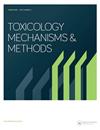没食子酸、槲皮素和柠檬烯对氨基甲酸乙酯诱导的黑腹果蝇遗传毒性和氧化应激的改善作用
IF 2.7
4区 医学
Q2 TOXICOLOGY
引用次数: 20
摘要
摘要我们目前工作的主要目的是确定果蝇模型在评估膳食植物化学物质没食子酸(GA)、槲皮素(QC)和柠檬烯(Lim)对氨基甲酸酯(URE)(一种遗传毒性环境致癌物)的抗原毒性和抗氧化作用方面的功效。用GA、QC和Lim与URE(20 mM)在10%蔗糖中72 h.给三龄幼虫喂食含有上述植物化学物质和URE的即时培养基24小时 h.进行性连锁隐性致死(SLRL)试验和谷胱甘肽含量(GSH)、谷胱甘肽S-转移酶(GST)、过氧化氢酶(CAT)、超氧化物歧化酶(SOD)和脂质过氧化(MDA)含量的测定。成人饲养实验表明,与单独使用URE相比,用URE和测试植物化学物质共同处理苍蝇,在所有生殖细胞阶段都显著降低了SLRL突变的频率。幼虫喂养实验也显示出类似的模式。上述结果与测试试剂的抗氧化潜力密切相关,我们观察到果蝇幼虫中酶水平升高,MDA水平显著降低。研究结果进一步表明,膳食中的植物化学物质具有抗氧化和抗突变特性,可以用黑腹果蝇进行评估。本文章由计算机程序翻译,如有差异,请以英文原文为准。
Ameliorative effects of gallic acid, quercetin and limonene on urethane-induced genotoxicity and oxidative stress in Drosophila melanogaster
Abstract The main objective of our present work was to ascertain the efficacy of Drosophila melanogaster model for assessing antigenotoxic and antioxidant effects of dietary phytochemicals gallic acid (GA), quercetin (QC) and limonene (Lim) against urethane (URE), a genotoxic environmental carcinogen. Oregon-K (ORK) adult male flies were fed GA, QC and Lim in combination with URE (20 mM) in 10% sucrose for 72 h. Third instar larvae were fed instant medium containing the above phytochemicals and URE for 24 h. Sex-linked recessive lethal (SLRL) test and assays for estimating glutathione content (GSH), glutathione S-transferase (GST), catalase (CAT), superoxide dismutase (SOD) and lipid peroxidation (MDA content) were performed. Adult feeding experiments demonstrated that co-treatment of flies with URE and the test phytochemicals has significantly decreased the frequencies of SLRL mutations in all the germ cell stages when compared to that with URE alone. Larval feeding experiments also showed a similar pattern. The above results correlate well with antioxidative potentials of the test agents where we observed the elevated enzymatic levels with a significant reduction in MDA level in Drosophila larvae. The results further suggest that the dietary phytochemicals have an antioxidant and antimutagenic property which can be assessed using D. melanogaster.
求助全文
通过发布文献求助,成功后即可免费获取论文全文。
去求助
来源期刊

Toxicology Mechanisms and Methods
TOXICOLOGY-
自引率
3.10%
发文量
66
期刊介绍:
Toxicology Mechanisms and Methods is a peer-reviewed journal whose aim is twofold. Firstly, the journal contains original research on subjects dealing with the mechanisms by which foreign chemicals cause toxic tissue injury. Chemical substances of interest include industrial compounds, environmental pollutants, hazardous wastes, drugs, pesticides, and chemical warfare agents. The scope of the journal spans from molecular and cellular mechanisms of action to the consideration of mechanistic evidence in establishing regulatory policy.
Secondly, the journal addresses aspects of the development, validation, and application of new and existing laboratory methods, techniques, and equipment. A variety of research methods are discussed, including:
In vivo studies with standard and alternative species
In vitro studies and alternative methodologies
Molecular, biochemical, and cellular techniques
Pharmacokinetics and pharmacodynamics
Mathematical modeling and computer programs
Forensic analyses
Risk assessment
Data collection and analysis.
 求助内容:
求助内容: 应助结果提醒方式:
应助结果提醒方式:


